Pomegranate, also known as Anar in Hindi, is a commercial crop in India. Persia is its place of origin. Carbohydrates, proteins, calcium, phosphorus, iron, and vitamin C are abundant in Pomegranate. Not only eaten as fresh fruit, but pomegranate juice is also refreshing and cool. Pomegranates have medicinal value in all parts, in addition to their juice. Diarrhea, dysentery, and worm-killing are cured by its root and peel.
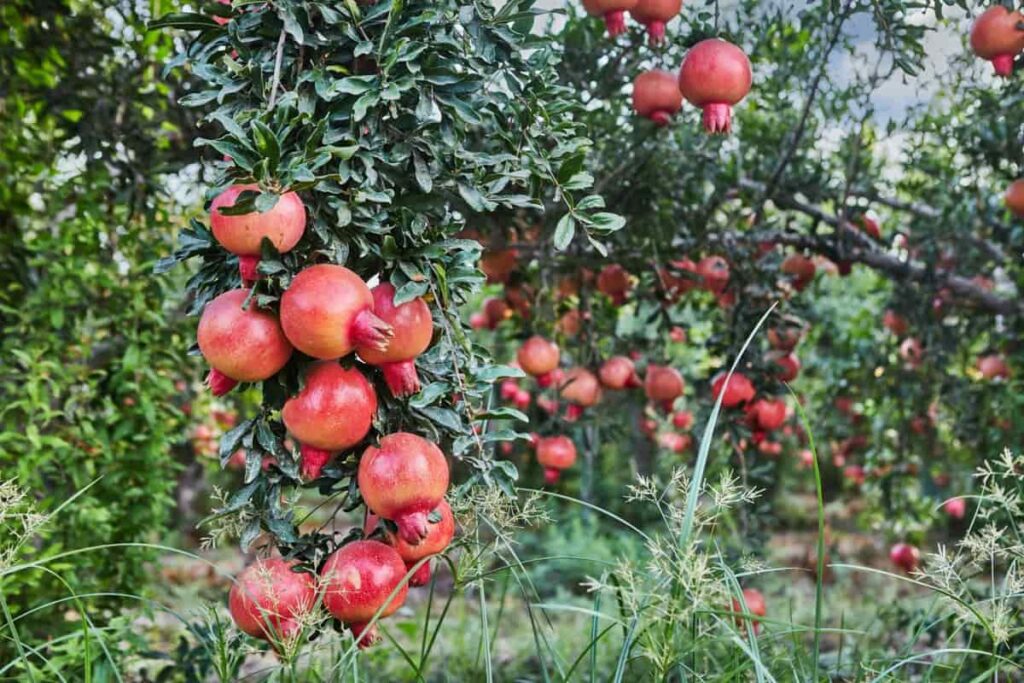
Dyes are prepared from their petals. Additionally, it is used to make processed products such as juice, syrup, squash, jelly, anar rub, juice concentrates, carbonated drinks, anar dana tablets, acids, etc. There is a 50-year lifespan for pomegranate trees. Farmers benefit from this since they don’t have to replant every year. As a result, pomegranates are produced in large quantities in Maharashtra.
However, pomegranates are also grown on a small scale in other states, such as Rajasthan, Karnataka, Gujarat, Tamil Nadu, Uttar Pradesh, Andhra Pradesh, Punjab, and Haryana. There are 2,25,000 acres of land in Maharashtra, with a production of 9.45 lakh tons and a production per acre of 4 tons. Regarding total area and production, Maharashtra accounts for 78 percent of India’s total.
Growing Pomegranate organically in Maharashtra
How does the Maharashtra government support organic farming
Maharashtra’s state government launched a policy for organic farming. Using local natural resources for farming and rejecting chemicals is what organic farming is defined as in the policy. In this scheme, farmers are encouraged to use organic inputs to improve soil fertility, certify organic agricultural areas, sell organic products, brand organic agricultural products, and promote organic agriculture.
In case you missed it: Growing Banana Organically in Maharashtra: Cultivation Practices and Production Management
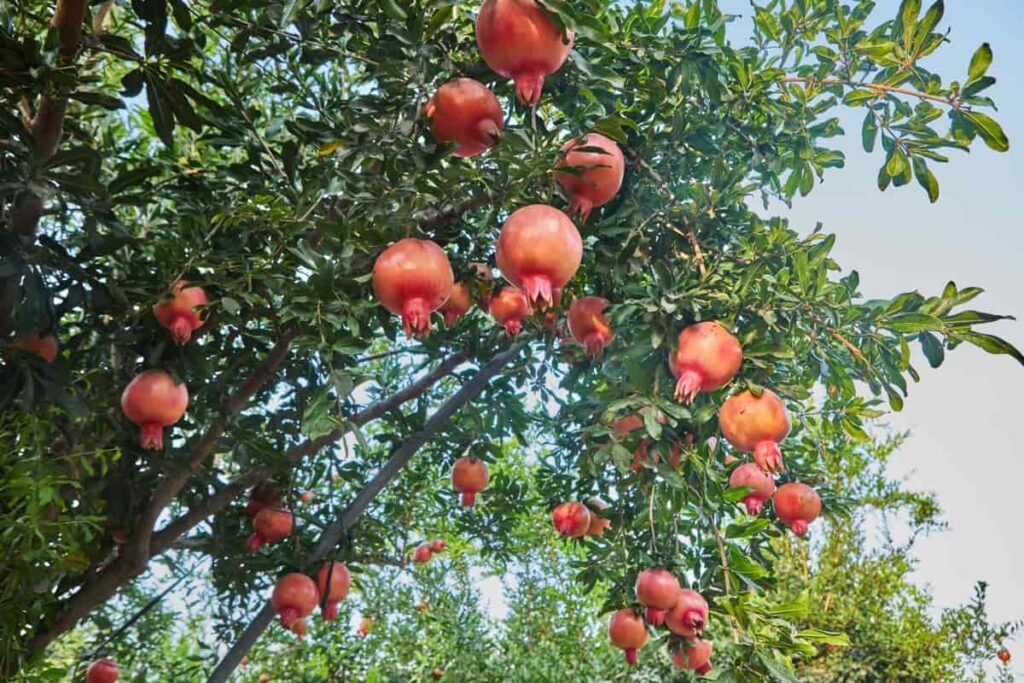
Benefits of state organic farming policy
- To get the benefits of low-cost organic farming
- To get the benefits of saving money in organic farming
- To get the benefits of nullifying the use of fertilizers and pesticides
- To get benefits of subsidy in organic farming
- To get benefits of organic farming economically and ecologically
Pomegranate varieties
1. Super saffron: The fruits of this variety are smooth, shiny, and large in size of saffron. Its seeds are soft. If managed well, about 40 – 50 kg yield can be obtained from each plant. This variety is considered very suitable in Rajasthan and Maharashtra.
2. Jyothi: This variety was developed at IIHR, Bangalore. The fruits are large with attractive colors having dark red arils. The seeds are very soft, with high pulp and juice contents. Aryls are pink in between. It tastes very sweet to eat. Fruits are borne on the canopy’s inner side and thus are not damaged due to sun scorch.
In case you missed it: Growing Onions Organically in Maharashtra: Cultivation Practices and Production Management
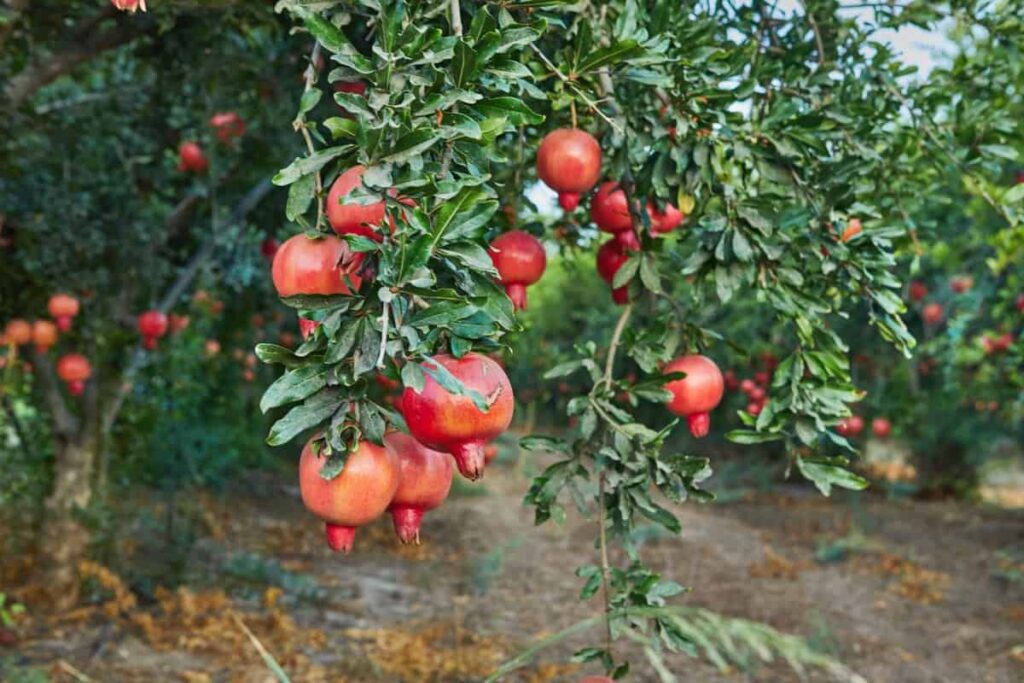
3. Mridula: Fruits of this variety are medium-sized to dark red color with a smooth surface. The dark red-colored seeds are soft, juicy, and sweet. The average weight of fruits of this variety is 250 – 300 grams.
4. Arakta: It is a high-yielding variety. Its fruits are large, with sweet, soft seeds. The aril is red, and the skin is an attractive red color. If cultivated properly, 25 to 30 kg yield can be obtained from each plant.
5. Ruby: This variety is developed at IIHR, Bangalore. The mature fruits resemble the cultivar ‘Ganesh’ concerning shape and size. However, the rind of this variety is reddish brown with green streaks containing bold red arils. The fruit weighs 270 grams with an average yield of 6-7 tonnes/acre.
Agro-climatic requirements for Pomegranate cultivation
A pomegranate tree can grow to a height of 500 meters above mean sea level under semi-arid conditions. As long as irrigation facilities are available, it thrives in hot, dry summers and cold winters. However, the tree requires a hot and dry climate during fruit development and ripening.
Therefore, pomegranates are deciduous in low-temperature areas and evergreen or partially deciduous in tropical and sub-tropical areas. During the dormant stage, it can tolerate frost considerably, but below -11°C, it is severely damaged. Fruit develops best at a temperature of 35°C to 38°C.
In case you missed it: Hydroponic Farming Cost and Profit in India: Cultivation and Production Management
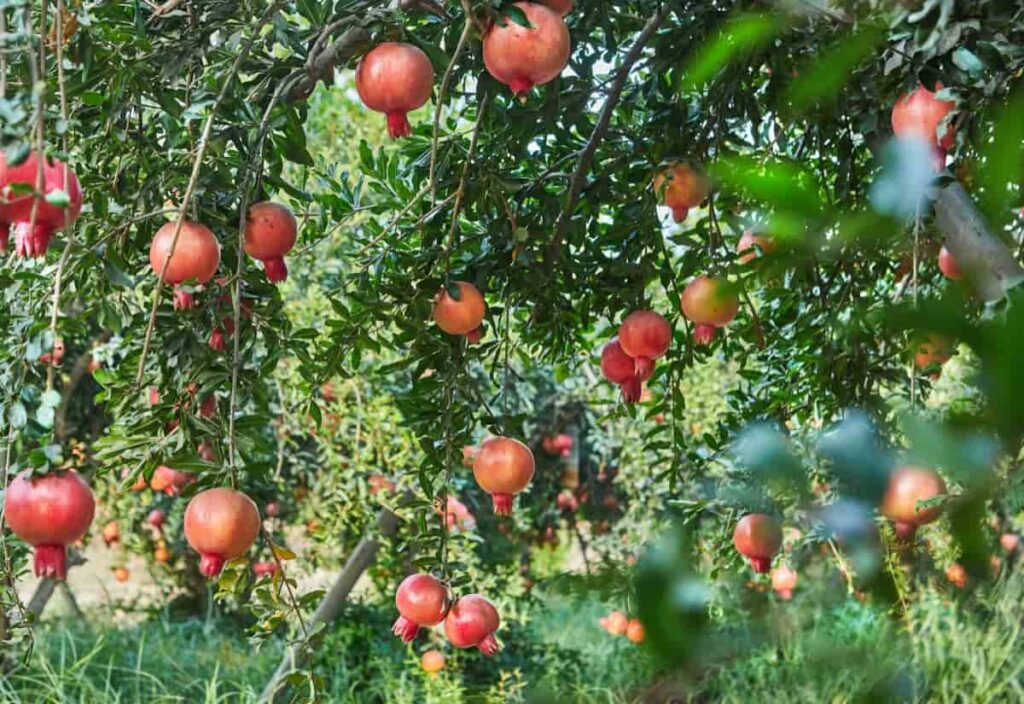
Soil for Pomegranate cultivation
It is recommended to grow pomegranates on deep, heavy loamy soils with good drainage capacity, although they can grow in various soil types. The plant can cope with alkalinity and salinity up to a certain extent. The presence of moisture in the soil, however, causes fruit cracking and lower yields. Therefore, it is ideal for growing pomegranates on soil ranging from pH 6.5 to 7.5.
Seasons for cultivating Pomegranate
During the spring months (February-March), pomegranates are planted in subtropical regions. A pomegranate plantation usually takes place during July and August in tropical regions. Air layering typically occurs during the rainy season and in November and December.
Land preparation and planting method for Pomegranate crop
A thorough plowing is done before pomegranate cultivation begins. During plow-down, the soil is broken up, debris is removed, and the subsoil is brought to the surface. Removing unwanted soil materials, such as rocks, stones, and pebbles, is necessary. A fine texture is achieved by making the soil soft and loose. The purpose of this step is to promote air circulation in the soil.
During plowing, organic matter is sometimes mixed with the soil. After plowing, the land is leveled and prepared for planting. Most people use the square system of planting. Depending on the soil type and climate, the planting distance is determined. It is recommended to space plants 4-5 meters apart on marginal and very light soils. About a month before planting, 60 X 60 X 60 cm pits are dug (at a spacing of 5 cm in a square system) and kept under the sun for a fortnight.
In case you missed it: Growing Pineapple Organically in West Bengal: Farming Practices and Production Guide
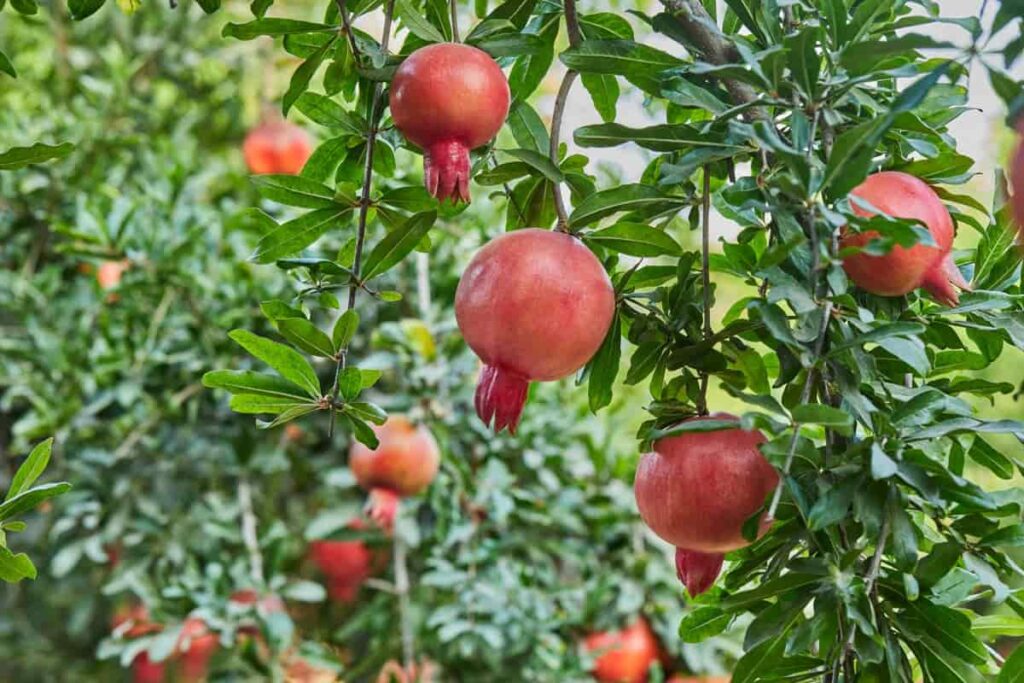
As a precaution against termites, 50 grams of 5% benzene hexachloride (BHC) are applied to the bottom and sides of the pits. A mixture of topsoil and farmyard manure combined with 1 kg of rock phosphate fills the pits. When the pit is filled, the soil settles down by the water. The cuttings/air layers are then staked and planted. After planting, irrigation is provided.
Irrigation requirements in Pomegranate cultivation
Pomegranate is a drought-tolerant fruit crop that can tolerate some underwater scarcity. Fruit splitting, the major problem of fruits, can also be reduced by regular irrigation. Irrigation should be applied every 10 to 12 days during winter and every 4 to 5 days during summer. Most farmers used drip irrigation to supply water, saving water and making fertilizer application easier. Drip irrigation requires 20 cm of water on average per year. The use of drip irrigation can reduce irrigation costs by 44%, and sugarcane trash mulch can reduce irrigation costs by 64%. Additionally, it increases yield by 30-35%.
Manure application in organic Pomegranate cultivation
Your soil test results indicate a healthy balance of nutrients for your plants. If that is the case, you might consider adding organic matter and nutrients to maintain soil and plant health. Between late winter and midsummer, compost can be applied to the soil as a top dressing in a three- to four-inch-thick layer or raked into the top two to three inches of soil. Ensure that the compost reaches all of the roots by spreading it along the drip line of the plant’s canopy.
Do not dig too deep, as you do not want to damage roots below the soil’s surface. You can boost your tree or shrub before the growing season begins by adding well-aged manure or shredded leaf mulch to the soil in late winter. As a result, both can provide the plant with more nutrients and feed worms and beneficial microbes in the soil around it. If your soil is sandy, leaf mulch and manure can also help retain water.
In case you missed it: Top 10 Vegetables to Grow in Your Garden: A Complete Guide for Beginners
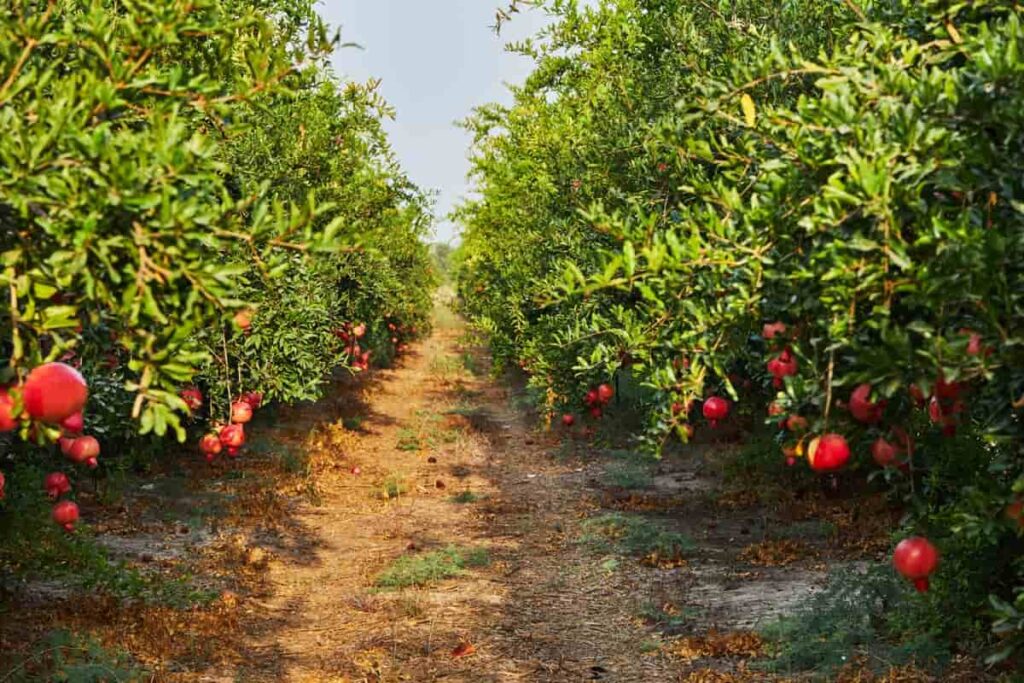
Training and pruning in Pomegranate
In addition to controlling vegetative growth and preserving tree shape and size, it enables proper light penetration in the tree’s center, facilitating cultural operations, spraying, and fruit harvesting. There are, however, two types of plant training systems: single-stem and multi-stem. It is more prevalent in the country to train crops using the other system because the single stem training system is more susceptible to pests, such as stem borer and shoot hole borer.
Propagation Method
Various methods can propagate pomegranate plants commercially, including hardwood cutting, air layering, and tissue culture.
Hardwood Cutting Propagation
Even though it is an easy method, its success rate is lower, so it is not popular among farmers. Cuttings from a one-year-old tree with a length of 25 to 30 cm (9 to 12 inches) are better rooted and survived if they have 4-5 buds.
Air-Layering Propagation
Farmers use this method to raise new plants most often. The air layering method requires plants to be 2 to 3 years old. Approximately 150 to 200 rooted cuttings can be obtained from a single plant. Layering is best done during the rainy season. The process of establishing roots takes around 30 days. Approximately 45 days after layering, the plants need to be separated from the mother plant.
Tissue Culture Propagation
In tissue culture, plants can be multiplied rapidly and in a controlled environment. By using this technique, you can quickly obtain disease-free planting material. Pomegranate plant nurseries offer this plant for sale; purchase it from a reputable retailer.
Pests in Pomegranate crops and their organic control
Pomegranate fruit borer
Symptoms
Young fruits are eaten by caterpillars. The fruit may rot and drop due to the feeding on the internal contents (pulps and seeds).
In case you missed it: 20 Key Rules for Setting Up a Budget Hydroponic Garden at Home
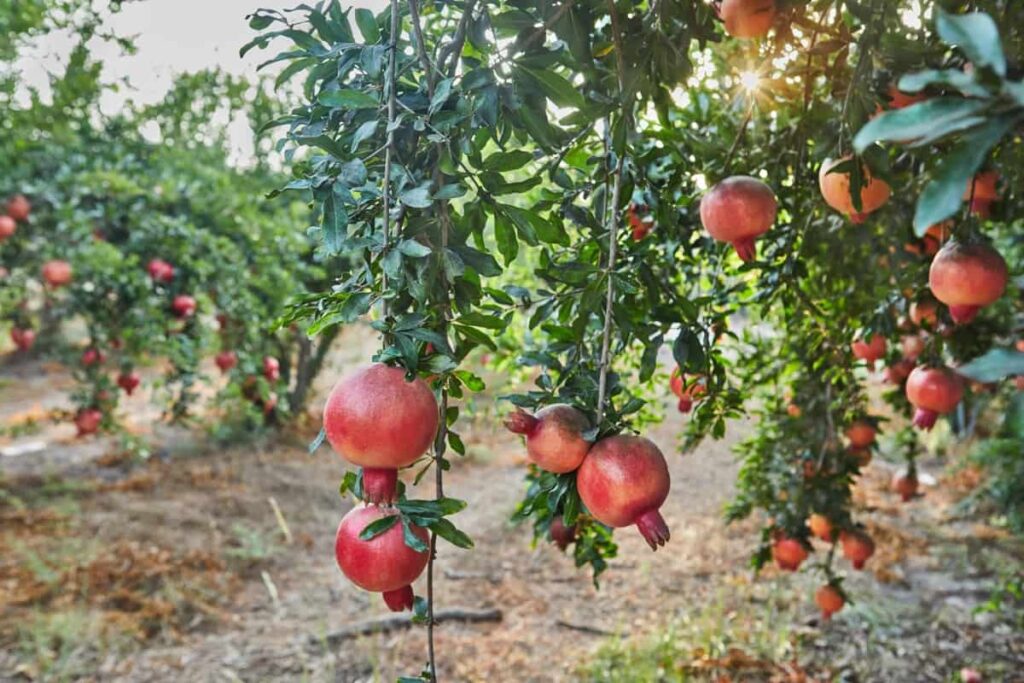
Control
- Clean cultivation and maintenance of the health and vigor of the tree should be followed.
- If screened with polythene or paper bags, the fruits may escape infestation.
- Remove and destroy all the affected fruits.
Thrips
Symptoms
The nymphs and adults consume the oozing sap from the underside of leaves by rasping the surface and sucking it. A browning and curled leaf tip cause flowers to dry and shed, as well as scabs on fruits, which reduces the market value of the fruit.
Control
- Prune the affected parts of the plant and destroy them.
- Detect early infestation by periodical monitoring for dry branches.
- Use of blue sticky traps @ 4-10 traps/acre
Stem borer
Symptoms: A grub bores into the trunk and feeds on sapwood. Beetles are active during the day and feed by gnawing green bark. You can usually see holes near the base of plants on the bark of main stems, excreta, and dry powdered material.
Control
- Damsel bugs, elm leaf beetle, some spiders, big-eyed bugs, parasitoid tachinid flies, or braconid wasps are all-natural enemies of the stem borer.
- Detect early infestation periodically by looking out for drying branches and pruning them
Diseases in Pomegranate crop and their organic control
Bacterial leaf and fruit spot
Symptoms
Small, dark-colored irregular spots resulting in premature leaf defoliation under severe conditions. Dark brown spots on the fruits were irregular, slightly raised, and oily.
Control
- Clean cultivation and strict sanitation in the orchard
- Prune and burning affected branches and fruits should be done regularly
- Collect and burn fallen infected leaves and fruits
In case you missed it: How to Fertilize Avocado Trees For Insane Fruit Set: Schedule for Natural, Organic, and Chemical Application

Anthracnose
Symptoms
Small, regular to irregular black spots on leaves, calyx region, and fruits which turn later on as dark brown depressed spots. Infected leaves turn yellow and drop off.
Control
- Wider plant spacing, yearly pruning of trees.
- Proper disposal of diseased leaves, twigs, and fruits.
Fusarium wilt
Symptoms
Affected plants show yellowing leaves in some twigs or branches, followed by drooping and drying leaves. When the affected tree is cut open lengthwise or cross-section, dark grayish-brown discoloration of wood is seen.
Control
- Soil application with bacillus subtilis shows a decline in wilt infections.
- Treatment with Trichoderma sp. combined with Paecilomyces sp. at 25 g with 2 kg of well-decomposed organic manure around the trunk of pomegranate trees helps to prevent wilt infections.
- Soil treatment with neem, Kranj, mahua, and castor cakes has been effective.
Harvesting Pomegranate crop
It takes 150 to 180 days from flowering to fruit maturity for pomegranates to be harvested. However, it depends on the genotype, climatic conditions, and growing region. When fruits are harvested too early, the fruits may be dull, immature, and improperly ripened, resulting in a dull, immature, and improper ripening process.
On the other hand, late harvesting results in a higher risk of diseases. Pomegranates are non-climacteric fruits that should be harvested when they are fully ripe. Secateurs or clippers are recommended for harvesting fruits because manual twisting may cause damage. Pomegranate trees can produce up to 12 to 15 kilograms per plant during their first year of growth. The plant yields around 15 to 20 kilograms annually from the second year onward.
Conclusion
The per acre yield of Pomegranate is 8 tons, far more than most other crops if taken good care of. But pomegranate farming comes with a few expenses too. Plant propagation, purchase of good quality plants, Land preparation, weeding, labor, irrigation set up, and harvesting costs are all incurred by the farmer. If you live in the following districts of Maharashtra and planning to start organic pomegranate farming, this guide will help you with plantation to harvest.
| Ahmednagar | Nagpur |
| Akola | Nanded |
| Amravati | Nandurbar |
| Aurangabad | Nashik |
| Beed | Osmanabad |
| Bhandara | Palghar |
| Buldhana | Parbhani |
| Chandrapur | Pune |
| Dhule | Raigad |
| Gadchiroli | Ratnagiri |
| Gondia | Sangli |
| Hingoli | Satara |
| Jalgaon | Sindhudurg |
| Jalna | Solapur |
| Kolhapur | Thane |
| Latur | Wardha |
| Mumbai City | Washim |
| Mumbai Suburban | Yavatmal |
- How to Raise Pigs in Your Own Backyard: A Comprehensive Guide
- Budget Friendly Sheep Shed Ideas: Cheap and Low-Cost Tips
- How Much Do Cattle Farmers Make: Revenue Streams in Cattle Farming
- Management Pests and Diseases in Your Cotton Field
- Sheep Farming Business Plan for Beginners
- Aquaponic Farming at Home: A Step-By-Step Guide
- Profitable Village Farming Business Ideas in 2024
- High-Yield Aquaculture: Fast-Growing Fish for Farming
- Effective Fish Pond Construction Techniques for Beginners
- Irrigation and Water Management in Pineapple Farming
- Blossom to Harvest: Mastering Flowering and Pollination in Papaya Farming
- Pig Fattening Essentials: From Selection to Sale for Beginners
- Raising Wagyu Cattle: A Complete Guide for Premium Beef Production
- Soil Types and Their Water Holding Capacity
- Optimizing Irrigation Schedules for Coconut Groves for Enhanced Yield
- Espresso Your Garden: Coffee Grounds for Healthier Acid-Loving Plants
- The Best Soil Mix for Snake Plants: How to Mix Your Own Snake Plant Soil
- Green Thumb Success: Expert Tips for Cultivating Greenhouse Beans All Year Round
- Bloom All Year Round: The Ultimate Guide to Indoor Hyacinth Care
- Eco-Friendly Gardening: How to Make Liquid Fertilizer from Kitchen Waste
- Ultimate Guide to Grow Anise in Pots: Explore Seed Propagation to Harvesting
- Guide to Raising Chester White Pigs: Discover Breed Facts to Growth Management
- Mastering the Elegance: The Ultimate Guide to Weeping Cherry Tree Care, Planting, and Maintenance
- Ultimate Guide to Planting Garlic in Grow Bags: Growing Strategies for Beginners
- How to Fix Spider Plant Leaf-Related Problems: Natural and Organic Remedies
- 10 Reasons Why Your Tulsi Plant is Shedding Leaves: Home Remedies and Solutions
- Optimizing Growth and Yield: The Advantages of Palm Bunch Ash Fertilizer
- Utilizing Neem Oil Extract as a Natural Pesticide for Hydrangea
- From Soil to Harvest: Various Ways in Which Farmers Can Use AI Tools
- Steps to Encourage and Induce Citrus Flowers: A Comprehensive Guide
- How to Fix Snake Plant Leaf-Related Issues: Natural and Organic Remedies
- Transform Your Garden into a Fragrant Oasis with Raat Ki Rani (Night Blooming Jasmine)
- Discover the Ideal Chicken Breeds for Philippine Farms
- How to Create a Poultry Egg Farm Business Plan for Profits
- Grow Lemon Cucumbers Like a Pro: Insider Techniques for Bountiful Yields
- Ultimate Guide to Caring for Your Pink Princess Philodendron: Tips for Thriving Variegation

Whats the biggest problem in pomegranate farming and whats the cost of cultivation per plant.